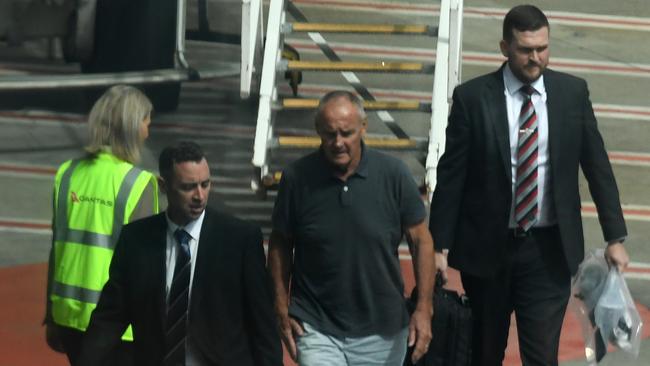The Teacher’s Pet: Chris Dawson and the curse of justice delayed
Chris Dawson is expected to make a move that may never see him face trial. But if he fails, the case will be riddled with complexity.

It can happen to teachers anywhere. They’re out in public and run into someone from the past, from school. It happened to Chris Dawson midair on Thursday.
High above the ground, in seat 30A in the far back corner of a Boeing 737-800, Dawson saw a flash of recognition pass over the face of a flight attendant.
“Your brother taught me at school,” he said as he served Dawson a breakfast quiche and can of Coke.
A brief conversation confirmed that Dawson’s twin, Paul, taught the attendant on Sydney’s northern beaches. Back then, the Dawson twins were not only teachers but celebrity footballers, turning heads wherever they went with their identical muscular builds, blond hair and confident auras.
“That’s lovely,” Dawson replied, according to a witness to the exchange.
Ordinary talk, except on this flight Dawson was awkwardly crammed beside two NSW homicide detectives. They were extraditing him to NSW on a charge of murdering his wife, Lyn, on the northern beaches 36 years earlier.
Australia’s most famous accused murderer, Dawson may have expected to be recognised for other reasons.
An investigative podcast series, The Teacher’s Pet, by this newspaper and its national chief correspondent, Hedley Thomas, has made the 70-year-old a household name: 16 episodes with 31 million downloads, focusing on the circumstances surrounding Lyn Dawson’s disappearance.
Since his calm arrest at his Gold Coast investment property on Wednesday, his notoriety has only grown. In Australia, the US, Canada, Britain and New Zealand, the case is back at No 1 on the podcast charts.
The road ahead has already been broadly mapped out. The battlelines are drawn and the punches telegraphed, if you look closely enough.
First, there will be a contested bail hearing. The showdown will take place on Friday in Sydney’s Central Local Court. Dawson had appeared briefly in the court via video link after his extradition flight this week; magistrate Robert Williams looked around and noted the “alarming number of people in the court for Dawson”.
Dawson could have pushed for his freedom there and then, but the court was told the crown prosecutor briefed on the case was not available. This bought time for the lawyers of the accused to sharpen their submissions and clear the air a little of the smoke from the media detonation that his arrest had triggered.
Dawson, whose main home is in Coolum on Queensland’s Sunshine Coast, wants to wait at the home of one of his brothers in Sydney while the wheels of justice turn. Bail is almost never granted on the most serious crime in the book; the risk is too high of flight or interference with witnesses.
Dawson’s age and clean criminal history will be in his favour. He’ll say there’s no risk of reoffending. His strongest argument may be that he’s had almost 37 years to flee, and never did.
But then, he’s also never been charged with murder before.
Dawson intends to plead not guilty, says his lawyer, Greg Walsh. So, within 10 weeks, by February 14, he will be served the prosecution’s large brief of evidence. It will reveal to him for the first time the full police case against him. His defence lawyers can apply to cross-examine witnesses to test some of the evidence. Or he can choose to skip the formalities and ask to go straight to trial in the Supreme Court.
Senior legal observers tell Inquirer they expect that in the months ahead Dawson will apply for a permanent stay of the proceedings so he never faces trial.
Arguably, he was in the dock this week as a result of the podcast series, which identified new evidence and witnesses who subsequently talked to police, and the tsunami of associated media attention. That’s not to diminish the role of the NSW Police Force homicide squad, which has been diligently reinvestigating Lyn’s disappearance since 2015, and whose evidence is yet to be publicly revealed.
Homicide squad commander Detective Superintendent Scott Cook presented the brief to the NSW Director of Public Prosecutions on April 9, five weeks before the podcast’s first episode was broadcast. In an accompanying letter, Cook asked DPP Lloyd Babb to reconsider his office’s previous position on the case and to say that in his view there was now enough evidence to charge Dawson.
Cook didn’t know, until it was revealed in the podcast series, that Babb had declared a conflict of interest and could have nothing to do with the case because Dawson was his rugby league coach at Sydney’s Asquith Boys High School. Babb had been school captain, and Dawson a teacher there. Responsibility for the sensitive Dawson matter had been quietly transferred to a deputy within the Office of the Director of Public Prosecutions.
On Monday, almost eight months after his letter, Cook met a group of senior DPP lawyers at their office in Liverpool Street, Sydney. He walked out with the green light to charge Dawson with murder. A warrant was drawn up on Tuesday, and the rest is history.
Would the DPP have acted without new witnesses identified by the podcast and the overwhelming public interest, in all senses of that term? Or would it all have been too long ago, too hard? An easy pass in favour of putting finite resources elsewhere?
Now, there’s a catch 22. If Dawson does go for a stay, as expected, he can argue the global publicity means he will never receive a fair trial.
That’s not necessarily a huge obstacle for the prosecution; it’s not the first high-profile criminal case, nor will it be the last.
Where Dawson may really push hard was signposted on the day of his arrest, in a brief but carefully crafted public statement issued by his brother Peter.
“We are disappointed at the decision of the DPP as there is clear and uncontested evidence that Lyn Dawson was alive long after she left Chris and her daughters,” it read. “We have no doubt whatsoever that Chris Dawson will be found not guilty, as he is innocent.”
The key portion, besides the optics of family support, was the claim that there was evidence essentially exonerating Dawson by proving Lyn was alive after the night of January 8, 1982, when he is accused of murdering her at the Bayview home, where they lived with their two young daughters.
Walsh, Dawson’s lawyer, elaborated outside the Local Court on Thursday. “After the disappearance of Lynette Dawson, there was evidence that she was observed by a number of people,” he said. “Unfortunately, two of those people are deceased.”
The daughter of one of these witnesses gave evidence at a 2003 inquest into Lyn’s disappearance, Walsh said. “She said, ‘my mother told me, and if she was here today she would say that she saw Lyn Dawson’. Another witness also gave evidence to that effect.”
Walsh said there were also two “very important Bankcard transactions” in the weeks after Lyn vanished that “regrettably were never investigated by the police”.
“Police should’ve conducted proper investigations and got witness statements at the time, which would’ve indicated probably she was alive,” he said.
“There has been a significant delay in this case, and there’s been inadequacies in the investigation by police.”
Police rebut these statements. But they are presumably the key arguments Dawson’s lawyers will push at a stay application or trial — that he cannot properly defend himself because of the passage of time and missed opportunities and because police did not do, their jobs when Lyn first went missing.
Again, it’s far from the first historical murder charge, and police today must play with the cards they have been dealt. The prosecution, to be led by the DPP’s deputy senior crown prosecutor, Craig Everson, will have powerful counter-arguments.
If a permanent stay is rejected, Dawson may seek a temporary one to delay the prosecution for years, until a jury’s memories have dimmed. Delay could certainly be tempting for Dawson if he’s successful in securing bail.
Which brings us to the question of whether Dawson will ask for a judge-only trial. On the surface, it could seem appealing to him, but his lawyers may view it as a risky strategy. A judge may be less likely to be swayed by appearances, such as when the clean-cut senior citizen sits in the dock.
Lawyer Walsh said yesterday he was still assessing a large volume of material from the case but did not rule out applying for a stay.
He was introduced to Dawson by his brother Peter. He appears an impressive choice, striking a calm and measured tone as he talked of every citizen’s “fundamental right” to the presumption of innocence.
There’s a difficult and high-stakes strategic battle ahead.



